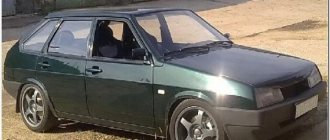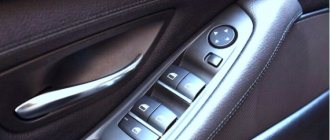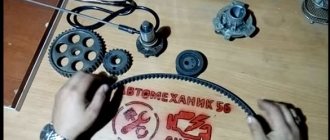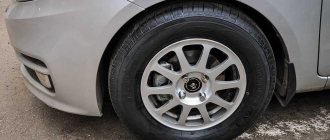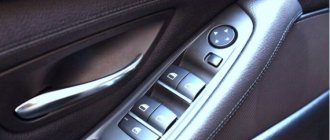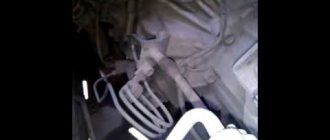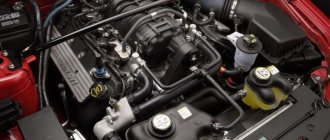If 1 cylinder does not work for you, then do not worry, this happens very often and for this reason it has received new names “ Trouble engine ” or “Missing” among car owners. In Soviet times, cars had four cylinders and when one of them did not work, people managed to drive a car with three cylinders. This type of driving is called “troit”.
Video of cylinder operation diagnostics:
Modern cars have from 3 to 12 cylinders, but the former name for this phenomenon has not lost its relevance and is used to this day. If the first cylinder does not work, then this is easy to notice by an unfamiliar sound constantly emanating from the car, interruptions in engine operation and unpleasant vibration of the body.
Of course, you can drive with one cylinder damaged; you have other good ones, but this is quite dangerous, both for the engine, which wears out quickly and will require expensive repairs, and for the life of the driver.
Driving with an inoperative cylinder leads to the fact that the fuel in the faulty cylinder does not burn and, mixed with oil, enters the crankcase, where it damages the cylinder walls and does not perform its main function - lubrication of the remaining cylinders.
Signs of engine tripping
Troubleshooting is usually called the failure of one or more cylinders. This is due to the widespread use of four-cylinder automobile engines in the USSR and the disregard for their maintenance, which gave rise to the failure of individual cylinders with subsequent blame for the problems of Soviet technology.
In fact, five, six, or eleven can remain working, depending on which engine and which car. But the signs are similar in all cases:
- the appearance of noticeable vibration from the engine, it can be quite comfortable, but was previously absent;
- characteristic ragged notes appear in the sound of the engine, as the absolutely uniform sequence of flashes has changed to a more complex and arrhythmic one;
- if you attach a piece of paper to the exhaust pipe, you will notice how it twitches in time with every fourth portion of the exhaust gases (if there are still four cylinders);
- The “Check Engine” indicator light on the dashboard will definitely come on, which means that the electronic engine control unit (ECU) has detected a problem.
Self-diagnosis built into the ECU can guess the source of the malfunction, but more often it is necessary to carry out a more complex search using diagnostic equipment.
No compression
The absence of compression (or its low value) indicates wear of the engine mechanisms. The reasons for the complete lack of compression can be:
Incorrectly adjusted valve clearances. If there is no gap, this indicates that the valve is “clamped” and is always in the open position. If the valve is clamped and the gaps cannot be reduced, this may indicate “sagging” valve seats.
Valve burnout. Gas-powered vehicles are especially susceptible to this and have incorrectly adjusted valves.
Burnout of the cylinder head gasket. Burnout of the gasket may be accompanied by the “disappearance” of coolant from the cooling system and the appearance of white smoke from the exhaust pipe.
Occurrence of piston rings. Typically, the rings become stuck after the engine overheats, when the oil burns out, and the rings stick into the recesses in the pistons.
A low compression value indicates natural wear of the rings and cylinder-piston group. The exact cause of the drop in compression can only be identified after opening the cylinder head.
Causes of malfunction
If we remember the theory, then for a flash and a power stroke, you need to feed the mixture into the combustion chamber in the required quantity, compress it and set it on fire at a precisely defined moment. Based on this, you can think about possible reasons why this does not happen.
Mechanical breakdowns
For successful ignition, the fuel-air mixture must be well compressed. But if the engine has lost compression, for example, as a result of wear of the pistons, rings or burnt-out valves, and this did not happen in all cylinders at the same time, which is unlikely, then it will just tune up. You'll have to take a pressure gauge and check the compression.
On the subject: Why does a diesel engine bleed and what to do
Mechanical problems may also include problems with the gas distribution mechanism, which will lead to disruptions in the flow of the mixture. But this is unlikely to happen with a separate cylinder and without loss of compression.
Supply system
There are many components and parts in it, but most of them relate to all engine cylinders. Only fuel injectors operate separately, so failure of one of them will lead to disruption of the stability of flashes specifically over a single piston.
The reasons may vary. Most often this is valve wear or clogged nozzles. The injector stops accurately dosing gasoline, and for it to ignite reliably, it must be mixed with air in a fairly accurately standardized proportion. When this is not done, the gasoline does not burn, the flash occurs, and the engine twitches.
When operating for a long time in this mode, the ECU will begin to rescue the faulty cylinder and completely turn off the injector in it. Otherwise, gasoline will wash away the oil from the walls, causing wear and scuffing.
Ignition system
Here, each cylinder of a modern engine usually has a separate spark plug and ignition coil. Failure of both will have exactly the same results - the cylinder will turn off.
There are engines with more ancient principles of organizing the final devices of the ignition system. In particular, one coil per pair of cylinders. If it fails, of course, the flashes will disappear in two at once, the engine will twitch much more strongly, and most likely it will simply stall.
Irregular tripping under load
The most difficult thing will be in the case when interruptions occur when opening the throttle and accelerating the car. That is, the parts have not yet completely failed, but are just unable to provide the load conditions. Diagnosis will be difficult; the experience of the master will tell you a lot.
By analyzing the ECU data, he can prepare a version and then test it practically. For example, if a spark plug partially fails, its gap will normally break through at low pressure in the cylinder and a lean mixture. But during acceleration, the conditions for a successful breakdown become more stringent, and the spark plug fails.
The technician can study the oscillogram data of the secondary ignition circuit, or he can simply pay attention to the appearance of the spark plugs.
“Trouble engine” - what is it?
When they say “the engine is trembling,” they mean that one or even several cylinders in the engine have begun to work poorly or have completely stopped participating in the engine’s operation. That is, the fuel-air mixture has stopped burning in them. It is very easy to understand that the car’s engine has begun to “trouble.” In this operating mode, the engine begins to shake noticeably, and vibration from it is transmitted to the car body. Usually, the “triple” of the engine is accompanied by the fact that it stops “pulling” the car, since it does not have enough power. In this article we will even consider those malfunctions due to which I cannot even work fully all the cylinders at once, and not just one or two.
How to check which cylinder is not working
The easiest way is to look into the ECU error memory using a scanner and diagnostic program. It will indicate how many misfires occurred and in which cylinder.
Unfortunately, this data is not always accurate. The dip counter is not always precisely synchronized with the timing disc on the crankshaft pulley, so it can point to the faulty cylinder.
But this is easy to check; just remove the connector from the injector. On a faulty cylinder, this will not affect the operation of the engine in any way, but if the working one is turned off, the engine will “limp” much more.
Ignition system
After identifying a bad cylinder, it is necessary to unscrew the spark plugs and inspect them. When the spark plug is working properly, its side electrode should not have heavy carbon deposits, and its color should be light and slightly brown. If there is black carbon on the spark plug, this indicates that the spark plug was filled with a large amount of gasoline or oil.
The candle body itself should be white and there should be no colored (usually brown or black) stripes or dots on it. Their presence indicates that the candle is “breaking” and is not able to work properly.
The spark plug is checked as follows: the spark plug is unscrewed from the engine, inserted into the tip of the spark plug wire and placed on any metal part of the engine (this will serve as a “ground”). An assistant should turn the engine with the starter, and another person should look at the spark strength on the spark plugs. If the spark is weak or completely absent, then it is better to replace the “non-working” spark plug with a working spark plug. If this time the working spark plug suddenly stops working (and the non-working spark plug starts working), then the problem is in the wire, distributor or coil. The spark plug wires can also be checked. This is done as follows. First, they are visually inspected for damage. If everything looks good, you need to measure the resistance of the wires with a multimeter, it should be about 20 ohms. If the value is different, then the wire needs to be sent for replacement.
Where to look for the cause of a non-working cylinder
The remark is that the check and search for the cause are carried out in a garage. There are two options: mechanical and electrical (ignition). You need to start taking the easy path, namely with ignition diagnostics.
- Spark plug. We determine their performance the old fashioned way. Visually, the side electrode and insulator should be light brown, but not black with soot flakes. A sooty electrode indicates either that the mixture is too rich or that it is splashed with oil. Sparking. Having inserted the spark plug into the explosive wire, bring it at a distance of 1-2 cm to the cylinder block and crank it with the starter. If the spark “jumps” this distance, then the spark plug is ok, if not, then we change it.
- High voltage wires. We check them for mechanical damage. We check their tips. If there is a light gray coating on the tip of the explosive wire, this indicates its operation in extreme mode. The resistance of explosive wires is checked with a multimeter. Different engines have different lengths of explosive wires and different resistances. Unless otherwise stated, 20 Kom is considered to be a constant resistance value. If the resistance is higher, you need to look for the cause in the explosive wire.
- Distributor. If the spark plug is faulty, then we will see a “breakdown” in the ignition distributor cap. Be sure to check the “coal”, you can stretch the spring a little.
- The explosive wires are simply mixed up. And it is precisely because of this that one or two cylinders do not work.
Next we move on to mechanics.
- Injector. It is quite possible that one cylinder is not working due to problems with the injector. This is either a malfunction of the injector itself, or the injector is clogged with low-quality fuel, or rather, because there is a lot of fuel in it. By the way, be careful and picky when using the “super-miracle” fuel purifiers that are sold on every corner. Ideally, diagnostics and cleaning of injectors should be carried out on a bench.
- Timing belt Fuel - the air mixture enters the cylinders in the wrong quantity and quality. There are a lot of reasons here. The belt is installed incorrectly, the tensioners are worn out, the seal is worn out. The camshaft is worn out, hydraulic compensators are worn out. A blown cylinder head gasket is usually due to engine overheating (look carefully at yourself when you want to ask why it overheated) during sporty driving, or a decrease in coolant level.
These are the traditional reasons why one cylinder of the engine does not work. And this is still an incomplete list. In any case, searching for the cause will lead you to the desired result, and you will eliminate this malfunction. On your own or with the help of a service.
Good luck identifying the cause and correcting the failed cylinder.
Home →
Practical advice →
Malfunctions →
What happens if you ignore cylinder failure?
It is not advisable to drive without one cylinder. But you shouldn’t turn to the services of a tow truck because of this either. You can also get to the repair site using the remaining ones.
Some engines will quickly take care of shutting down the faulty cylinder for preventive purposes. But you shouldn’t hope for this, the ECU is quite capable of confusing and turning off the working one, or maybe not completely shutting off the gasoline.
Therefore, it is better to remove the connector from the injector yourself. If it does not “flow” when closed, this will save the cylinder walls from premature abrasion by dry rings.
There are engines where it is very difficult to turn off the fuel supply to a faulty cylinder. This type of car is best repaired on site.
Not only is driving with unburned gasoline washing the pistons fraught with scuffing, but if fuel gets into the crankcase, it kills all the characteristics of the engine oil. Overheating and rotation of the liners will end very badly. It is better to fix the problem or use a tow truck.
Source
Minus one: easy ways to find the cause of the motor tripping
This is “boo-boo-boo” for a reason!
There will be very little theory today.
Engine trouble is when, for some reason, on a four-cylinder engine, one of the cylinders begins to misfire. Although once on the Internet I came across a funny theory that tripling is when one of the strokes is missing in a four-stroke engine. Well, it happens. I will not comment on this scientific discovery. Anyone who started their journey as a motorist with a “nine” or something similar spiritual and strong will immediately roll up their sleeves and in most cases find the cause of the malfunction. Those who have recently driven a fuel-injected car and confuse the DPKV (which we wrote about not long ago) and the oxygen sensor have a more difficult time. It seems that there are too many smart things, blocks, sensors and other “computers”, and it’s difficult to understand such a motor. There is some truth in this. The death of the same DPKV can lead to an uncertain start of the engine and to its tripping. But let's face it: it's not very often that these sensors die on their own, and the reason for the tripping is much more often much simpler. And finding it on your own is not only easy, but also pleasant.
The tripling itself is impossible not to notice. The engine runs unevenly, instead of a uniform “trrrrr”, some kind of uneven “trrr-bu-trrr-boo” is heard from the exhaust pipe, and sometimes it can make a rather loud bang (if gasoline accumulates in the exhaust, evaporates and escapes from the heating iron). Sometimes (but not always) the Check Engine light will flash or stay on. And this is already a good reason to do diagnostics.
I want to warn you right away: computer diagnostics in themselves are a necessary and good thing, but you shouldn’t hope that someone will connect their Chinese ELM 327 scanner to your car for 500 rubles and immediately make a diagnosis. Most likely, the result of such a diagnosis will be the phrase “misfire in such and such a cylinder,” and that’s all. Why the pass, where does the pass come from, what to do with it - all this confuses such a would-be diagnostician. In response, you will see his look, the way a reclusive pensioner looks at Eldzhey, and you will hear an indistinct bleat. So if you don’t have the money or the desire to go straight to a good but expensive diagnostician, it makes sense to deal with the engine yourself. For example, I will disassemble the simplest naturally aspirated four-cylinder gasoline engine, of which the majority are found in modern budget cars.
I propose a non-standard approach to solving the problem. We will not go from causes to consequences, but vice versa - the way we encounter it in life. That is, we will first carefully examine under what conditions tripling occurs, and based on this information, we will think about why it might appear. Let's start with the simplest case - tripping after a morning start in wet weather.
Morning, rain, no spark
Situation: in warm and dry or fairly frosty weather, the engine starts easily in the morning, but in wet or rainy weather it is difficult. After starting, the engine starts to run smoothly as it warms up. This is the simplest and most classic case, which is quite easy to overcome.
Almost always in this case the ignition system is to blame - high-voltage wires or the ignition coil. During the night they can become damp, and the spark that escaped through the breakdown begins to walk along their damp surface. As it warms up and dries, the problem disappears on its own, and appears again in the morning. In dry weather, of course, much less often.
Of course, it would be best to have a scanner for this case: it would make it possible to determine exactly in which cylinder the misfires began. Then it would be easier: you know where to look. But if it’s not there, you can go the old fashioned way: start the engine, let it rev a little, then unscrew the spark plugs one by one. A spark plug wet from gasoline will indicate the cylinder that is too lazy to work in wet weather. By the way, you can also look at the candles. Replacing spark plugs in this situation rarely helps, but if they are bad, this is a reason to install new ones (only high-quality ones that are suitable for the engine, and not the first ones that come across).
Now we need to find out what is the reason for the lack of spark. Just don’t laugh, but the old fashioned method works not only on Zhiguli and Moskvich cars, but also on quite modern injection engines: you need to look at the engine running in the dark, in the morning or in the evening. Well, or at night, if triple vision does not allow you to sleep peacefully. A broken high-voltage wire can be seen immediately by beautiful sparks that should not be on it. If for some reason he cannot “drag” the spark to the spark plug, this spark will still come out somewhere. Most likely, in the place where the wire insulation has worn out or cracked due to age. We haven’t learned how to repair the wires yet, so it will have to be replaced. It’s better to do it all at once, because all wires have the same lifespan, and if one dies, soon all the others will die too.
The second reason is a breakdown of the ignition coil. There are several motors in which this is practically a birth defect - the coil “sews” to ground due to a breakdown of the housing. For example, the very popular Renault K7M/K4M engines or Ford Duratec 16V Sigma (for example, on second Focuses) and some others like to indulge in this. What to do: with these units the coil body is so close to the motor that it constantly overheats and begins to crack with age. Super-frugal people in this case do not change the coils, but repair them. For example, the body is doused with epoxy. Of course, this is a good dielectric, but it’s still better to replace the coil.
And here we move on to the main question: are the wires or the coil to blame? What to change first? If the method of checking in the dark did not help, then you can check both with a multimeter. You can inspect it externally: if there are areas that differ in color with incomprehensible dark dots, then these are the places where the coil or wire “sews” a spark. Well, the most reliable way is to ask someone for known good wires or a coil and exchange them with your own.
Less often, a candle is to blame for tripping in wet weather. It is not difficult to establish her guilt: you need to rearrange the candles. If, along with the spark plug, misfires also transfer to another cylinder, then the fault of the spark plug is proven. Rearranging will also help you find a faulty individual coil - the one that is placed on each spark plug separately.
There are several other methods by which you can find a breakdown of a coil or wire. They boil down to leaning the unscrewed spark plug against ground and turning the engine with the starter or slightly removing the tip of the wire from the spark plug and seeing if a spark appears between the wire and the spark plug. The methods work, but I would not recommend abusing them. Firstly, if you touch a wire (even if it’s not necessarily a broken one), you can get a great shock, and this is unpleasant. Secondly, if in the fresh air a spark jumps between the electrodes of the spark plug regularly, this does not mean that it will occur while the engine is running. There, the power of the spark may not be enough to cause a breakdown between the electrodes, and it will go to the insulator or even break through the damaged insulation of the high-voltage wire. Well, and thirdly, this way you can burn a still fully working ignition coil. So the accuracy of this method is conditional. No spark is definitely bad, and if there is one, it does not mean that it is always there.
Motor shakes under load
Here everything is much more complicated. If tripping begins at high speeds and at high speeds, the first thing you need to look at is the spark plugs. Especially if tripling is observed in a specific cylinder. If the spark plugs on a car are inexpensive, then they are easier to replace. The trouble has passed - good, no - we need to dig further. And in this case, digging without experience can take a long time. There are a great many reasons for tripping at high speeds, and finding the right one is quite difficult. There may be malfunctions of the sensors, a breakdown of the same coils or wires (but in this case, as I said above, the problem is more typical for wet weather), and the vagaries of the fuel pump or throttle valve. It happens that at high speeds a valve freezes due to carbon deposits, a broken or tired spring or a dead hydraulic compensator, or the ECU cannot determine the amount of gasoline supplied due to incorrect data from a dead lambda sensor. In a word, without experience and tools, it will be difficult to find the cause of the malfunction, and it is better to immediately go to the service center.
If you want to do at least something yourself, you can check if there is an air leak at the inlet. It makes sense to do this if all cylinders are affected alternately, and not just one, and the color of the side electrode of the spark plug is unnaturally light, even pale. Air not taken into account by the DBP or DMVR leads to a too lean mixture, and this is most noticeable just under load. If attempts to do something yourself are unsuccessful, it is better not to delay a visit to a car service: driving on a mixture that is too lean leads to severe overheating, burnout of valves and overheating of the ignition.
In the morning it starts, after warming up it stops, after pressing the gas it starts again
It sounds complicated, but the situation is very common. Most often, it is not the ignition that is to blame, but the power supply. First of all, unscrew the spark plugs and look at them. Most likely, one of them will be in dark soot. The reason in this case is the leaking injector. More often it is easier to change it, but some people prefer to clean the injectors or carry out other resuscitation procedures with them of varying degrees of effectiveness. On many cars, checking the serviceability of the injectors is easy: just remove the ramp from them and turn on the ignition. It drips from the nozzle - it does not hold pressure and overflows. Hence the tripping due to the too rich mixture in the cylinder with such an injector. And do not forget to install a new sealing ring when replacing the nozzle, otherwise the results of the repair will not be satisfactory. In general, of course, not everyone will want to remove the ramp themselves, but on some machines this is really easy to do.
Similar symptoms occur when the fuel pump is insufficiently efficient. In this case, the candles will not differ in soot, but the symptoms are similar. While the speed is low, there is enough fuel, but if you give it gas, it will no longer be enough. Unfortunately, to check the fuel pump yourself, you need at least a pressure gauge to measure the pressure on the fuel rail. A characteristic feature is that misfire will occur not in the same cylinder, but in all. It is difficult to confuse with a faulty injector, especially when using a scanner.
After starting it works well, but troits as it warms up
This rarely happens in life, and the search for the cause can take a long time. Most likely, without a minimum set of tools, it will be difficult to find the cause. Electrics are rarely at fault in this case; the most likely reason is purely mechanical. First of all, it is worth checking the compression and valve clearance adjustment. Most likely the valve clearance is broken somewhere. However, it wouldn’t be a bad idea to check the spark plugs, wires and coil – who knows? But then you still have to go to a service center for more serious diagnostics.
I'm my mother's engineer!
Of course, we did not consider many reasons for the engine tripping as a matter of principle. I intentionally missed low compression, sensor errors, phase discrepancies and much more. All this is difficult to diagnose without equipment and without experience. And such troubles are much less common than broken wires and a half-dead fuel pump. But the methods of basic search for the cause of tripling described above can help in many cases. Well, in order not to lead the situation to the need to look for a runaway spark, it is enough just to change the spark plugs and wires in a timely manner, carry out maintenance and not neglect minor shortcomings in the operation of the engine.
Even minor misfires due to an “almost” good spark plug can lead to a breakdown of the wire, and even worse, a breakdown of the coil, which can be quite expensive. Driving with three-wheel drive won't do any good either. It would be fine, but gasoline consumption increased and performance dropped, but no - the consequences can be much more varied and very unpleasant. For example, increased vibration of the motor kills both supports and loosely secured wiring elements. And the automatic transmission electronics can also go crazy, which does not understand why the crankshaft speed is constantly jumping sharply up and down.
In general, there can be many different consequences, although all this could have been avoided by purchasing a candle for 300 rubles. So, if you can’t do something yourself, it’s better to immediately put the car in the hands of professionals. Sometimes it works out much cheaper.
Survey
Have you ever had an engine trouble?
Your voice
Total votes:
Messages 14
1 Topic by kostya.ishekov93 2014-09-05 16:12:56
- kostya.ishekov93
- New member
- Inactive
- Registration: 2014-08-04
- Messages: 28 Thanks : 3
- Auto: 2110
Topic: Resolved: The 1st cylinder does not work, there is a spark
The 1st cylinder does not work. VV is normal, new, there is a spark. The injectors are new. There is compression) what is the problem? 2110 16 valves
2 Reply from igorek 2014-09-05 16:20:03 (2014-09-05 16:24:52 edited by igorek)
- igorek
- Brother-in-law
- Inactive
- From: Bryansk region g Starodub
- Registration: 2013-05-05
- Messages: 416 Thanks : 191
- Car: VAZ-21102 1.5i-8V Bosch MP7.0H
Re: Resolved: The 1st cylinder does not work, there is a spark
kostya.ishekov93 , 1st spark plug 2nd high-voltage coil. 3rd ignition module 4th injector control circuit. Is this all normal? and checked? If everything is normal, you can sin on the computer
3 Reply from kostya.ishekov93 2014-09-05 17:30:13 (2014-09-05 17:40:05 edited by kostya.ishekov93)
- kostya.ishekov93
- New member
- Inactive
- Registration: 2014-08-04
- Messages: 28 Thanks : 3
- Auto: 2110
Re: Resolved: The 1st cylinder does not work, there is a spark
kostya.ishekov93 , 1st spark plug 2nd high-voltage coil. 3rd ignition module 4th injector control circuit. Is this all normal? and checked? If everything is normal, you can sin on the computer
I checked the spark plug. I don’t have a coil, but a module) How can I check the module, or how can I understand what’s not working properly? The chain, as I understand it, if it were acting up, the check would show) The only error the check gives is 0301 Misfire in cylinder 1
